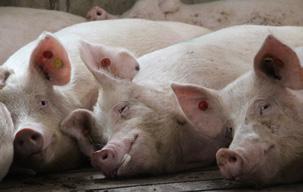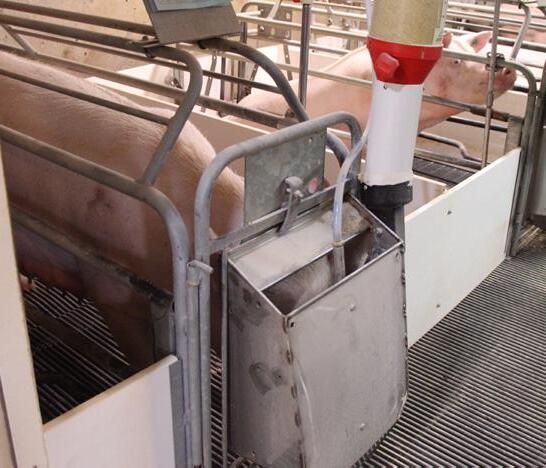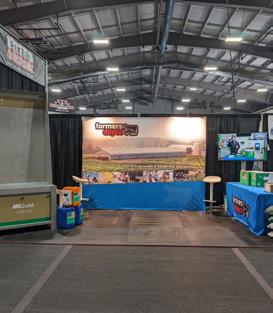
PO Box 726, Cambridge ON, N1R 5W6


PO Box 726, Cambridge ON, N1R 5W6


As the official start to summer nears, and we trust more seasonable temperatures arrive, we are pleased to provide you with a copy of our Swine Grist – Summer Edition. As discussed in Nicole Gregory’s article herein, although all of us humans appreciate and enjoy the summer heat after a fairly long, snowy winter, our herds often suffer the effects of heat stress during our Canadian summers, especially in times of high humidity. Nicole’s article provides some great tips and strategies to mitigate the effect of heat stress on your herd. Many Ontario producers appreciated Dr. Chantal Farmer’s presentation on feeding and managing transition sows at the Ontario Swine Conference (London, ON) in March. We are pleased to include an article from Dr. Farmer in this edition of the Swine Grist

by: Nicole Gregory, Ph.D. Monogastric Nutritionist
As the hot weather of summer approaches, it is important to find ways to keep both ourselves and our sows cool. Pigs have a difficult time dealing with heat compared to other animals, since they cannot sweat and have limited ability to pant. This makes it difficult for the pig to dissipate heat and maintain a comfortable body temperature. If a pig is unable to release enough heat to regulate its body temperature, the pig will enter what is called heat stress. Susceptibility to heat stress is a problem for the modern sow, since she is larger, leaner and more productive (producing larger litters and more milk in lactation), which are all factors that increase the amount of heat that her body produces. These factors make it difficult for the sow to maintain her body temperature once environmental temperatures exceed her thermal neutral zone of 22⁰ C, which is worse in times of high humidity. With temperatures on the rise and higher prevalences of heat waves around
1-800-567-4400 grandvalley.com
which summarizes well much of the information that she presented there. We are looking forward to our time together in Stratford on June 18th and 19th, at the Ontario Pork Congress. Please take the time to visit with us at our Grand Valley Fortifiers and Farmers Depot/MS Schippers booths in the Agriplex building. There you will be able to meet members of our newly expanded nutritionist team such as Nicole Gregory and Morgan Colling while learning about our new M2M sow top dress and further improvements to our always developing nursery feeding program, now under Kayla Silva’s leadership. See you there soon!
Sincerely, Ian Ross CEO, GVF group of companies

the globe, heat stress in sows is a true concern. When a sow is exposed to high temperatures, she will try to combat the environmental heat through reducing the heat she produces. To do this, a sow will decrease her feed intake to limit heat produced from digestion. Additionally, she will reduce blood flow to places like the gastrointestinal tract and mammary gland to allow for more blood to flow to the periphery of the body dissipate heat. This reduction in feed intake and blood flow creates a negative effect on sow performance through decreased nutrient intake, which increases body condition losses and reduces milk production in lactation. It also creates inflammation and oxidative stress in the body, leading to leaky gut in the gastrointestinal tract (Liu et al. 2022). Additionally, heat stress can impact the reproductive performance of the sows, reducing the amount and quality of oocytes released prior to breeding, higher occurrences of anestrus, and longer

wean to estrus intervals, all leading to lower farrowing rates and reduced litter size in the following lactation (Liu et al. 2022).

Ultimately, heat stress decreases the performance of both the nurse and dry sows and therefore it is important to be able to recognize the signs of heat stress. Sows under heat stress will have a high amount of panting, reduce their movements, increase time lying down, lie farther apart from one another in group pens, increase water consumption, and reduce voluntary feed intake. There are some management strategies to reduce the impact of heat stress. This can include ideal ventilation management to allow for increased air flow throughout the barn or the rooms, avoid overcrowding for sows in group housed pens, using misters or sprinkling systems to help cool the sows through evaporation, in-floor cooling, and cooling mats for sows in individual crates. Additionally, being mindful of the heat produced from heat lamps or mats in the creep areas and adjusting the temperature as needed during elevated environmental temperatures. While environmental changes are not always possible in every system, dietary management can also help sows manage during times of heat stress. Ensuring that all sows have unrestricted access to fresh, clean water is important throughout the year, but is especially important during times of increased temperatures, due to the increased requirements of water. Additionally, adjusting the feeding schedule to provide feed during the cooler times of the days (such as the early morning or evening) if possible, can help improve feed intake. It is also important to consider the amount of heat that is being created during digestion of the diet. Providing energy from nutrients that produce a lower amount of heat during digestions, such as dietary fat, can ensure proper energy density of the diets during times of elevated heat in the summer. Ingredients that are high in fibre produce high amounts of heat when digested, however fibre is important for dry sows to ensure proper satiety, therefore it is important to balance fibre to provide satiety while minimizing heat production. High levels of crude protein can also produce larger amounts of heat when digested. It has been shown that reducing crude protein while maintaining ideal amino acid ratios through crystalline amino acid inclusion was able to reduce the amount of heat that is produced (Zhang et al. 2020). Additionally, providing increased levels of antioxidants, like vitamin E and selenium, can help reduce the impact of oxidative stress on the gastrointestinal tract that can occur during heat stress. Identifying the signs of heat stress in your sows and implementing strategies to help mitigate the effects, this allows sows to continue to be productive throughout the heat of the summer and all year round. Contact your Nutritionist or Livestock Business Consultant today to plan your heat stress mitigation strategies.
References: Liu, F. , W. Zhao, H.H. Le, J.J. Cottrell, M.P. Green, B.J. Leury, F.R. Dunshea, A.W. Bell. 2022. Review: What have we learned about the effects of heat stress on the pig industry?. Animal. 16:sup2.
Zhang, S., J.S. Johnson and N.L Trottier. 2020. Effect of dietary near ideal amino acid profile on heat production of lactating sows exposed to thermal neutral and heat stress condition. Journal of Animal Science and Biotechnology. 11:75.

by: Chantal Farmer, Ph.D. Agriculture and Agri-Food Canada, Sherbrooke Research and Development Centre, QC, Canada
Swine producers are currently using sow genetic lines with very high litter sizes and, even though beneficial, this creates new dilemmas in the farrowing house. The problems of longer farrowings, greater stillbirth rate, and inadequate colostrum and milk intakes by individual piglets are often encountered. More attention needs to be given to the crucial period of transition between late gestation and early lactation to develop the best feeding and management strategies to assist sows and their progeny.
The transition period covers approximately the last week of gestation until a few days after farrowing. This is a crucial period when sows undergo major metabolic changes and must use their body reserves because of an imbalance between intake and use of nutrients. The energy status of sows is important for successful farrowings, with both inadequate and excess energy intakes having negative effects. Farrowing duration was shorter with minimal required assistance and lower stillbirth rate when sows were fed 3.7 to 4.1 kg/day of a lactation diet during the last week of gestation (Feyera et al., 2021). Time of farrowing relative to the last meal is important as farrowing duration was constant and shorter (3.8 ± 1.5 hours) when farrowings started within 3.1 ± 0.3 hours of the last meal, but farrowing duration increased to 9.3 hours with more stillbirths when farrowings started 8 hours after the last meal (Feyera et al., 2018). On the other hand, providing ad libitum feeding or four daily meals of a lactation diet from day 113 of gestation until farrowing did not alter farrowing duration or incidence of stillbirths when farrowing duration in the herd averaged 3.5 hours (Gourley et al., 2020). It is apparent that beneficial effects of energy status at farrowing may depend on the duration of farrowing and litter size normally seen in the herd. An adequate supply of nutrients during transition is also important to sustain the highly accelerated mammary development and the synthesis of colostrum. Decaluwé et al. (2014) reported that a very low feed supply (1.5 vs. 4.5 kg/day) from day 108 of gestation until farrowing tended to decrease colostrum yield and caused excessive mobilization of body reserves. Garrison et al. (2017) fed sows 1.5, 3.0 or 4.5 kg/day from day 104 of gestation until farrowing and reported a 9 g increase in colostrum yield with each 1 kg increase in daily feed intake. According to Feyera et al. (2021), who fed first- and second-parity sows 1.8 to 5.0 kg/day from day 108 of gestation until farrowing, colostrum yield was maximal at 3.0 kg/day. Interestingly, recent findings showed that feed intake during the last week of gestation could impact subsequent sow milk yield. Bruun et al. (2023) compared feed intakes ranging from 1.8 to 5.0 kg/day from day 108 of gestation until farrowing in first- and second-parity sows, and a feed supply of 4.0 to 4.1 kg/day maximized average milk yield in the subsequent lactation.

Taking into account the increased nutrient requirements of sows during late gestation, the gestation diet may not meet these needs. Lactation diets contain more protein than gestation diets and feeding a lactation diet instead of a gestation diet from day 107 of gestation until farrowing increased colostrum intake by piglets (127 versus 96 g) as well as piglet weaning weights (Garrison et al., 2017). Recent results indicate that dietary protein in the last week of gestation can also have a carry-over effects on subsequent milk production. Multiparous sows fed increasing levels of lysine (15.2 to 32.6 g/day of SID lysine) with a feed allowance of 3.8 kg/day from day 108 of gestation until 24 hours after the onset of farrowing, had optimal milk yield with a daily lysine intake of 22.0 g (Johannsen et al., 2024). On the other hand, Pedersen et al. (2020) found no carry-over effect of dietary protein supply (19.2 to 28.8 g SID lysine/day) during transition on milk yield, which may have been due to a below optimal feed intake.
Taking into account the increased cost of feeding a lactation diet in transition, the option of providing a daily blend of gestation and lactation diets that is adapted to meet the sow requirements could be an option. When sows were fed 2 kg of either a lactation diet or a daily blend of gestation and lactation diets (to best meet lysine and energy requirements) as of day 104 of gestation, the blend of diets increased body weight and backfat thickness of sows after farrowing, while piglet weaning weight was unaltered (Gregory and Huber, 2024). Transition feeding programs using such a blend therefore reduces energy mobilization by the sow during late gestation and has no detrimental effect on subsequent lactation performance. The major drawback, however, is the cost of the feeding system needed to make such a blend.

Constipation is commonly seen in late-pregnant sows and it can lead to prolonged farrowings. Dietary fibres have been used to reduce the incidence of constipation. Supplementing the diet of sows in the transition period (7 days before to 3 days after farrowing) with 75 g per day of lignocellulose decreased the rate of constipation from 46.3% to 17.6% without altering farrowing duration (Dumniem et al., 2024). When treated sows had 16 or more piglets, the increased fibre intake also tended to reduce farrowing duration (202.0 versus 287.5 minutes). Dietary fibre supplementation during the transition period may therefore be beneficial, mostly in sows with large litters.
Take home messages:
01. Special care must be provided when feeding sows during the transition period between gestation and lactation because they may be lacking energy and protein at this critical time.
02. A feed intake between 3.7 and 4.1 kg/day during the last week of gestation can decrease farrowing duration and stillbirth rate.
03. Farrowing duration was shorter and stillbirth rate lower when sows were provided feed in the 3.1 h preceding the onset of farrowing.
04. Colostrum yield was maximal with a daily feed intake of 3.0 kg from day 108 of gestation until farrowing.
05. Feeding a lactation diet from day 107 of gestation until farrowing increased colostrum intake and piglet weaning weights.
06. Dietary supplementation with fibre can decrease constipation and farrowing length, and this mainly in litters of 16 or more piglets.
References:
Bruun, T.S., M. Eskildsen, C.K. Hojgaard, N.P. Nørskov, K.E.B. Knudsen, P.K. Theil and T. Feyera, T. 2023. Feeding level during the last week of gestation can influence performance of sows and their litters in the subsequent lactation. J. Anim. Sci. 101:1-11. doi:10.1093/jas/skad349.
Decaluwé, R., D. Maes, A. Cools, B. Wuyts, S. De Smet, B. Marescau, D. Paul and G. Janssens. 2014. Effect of peripartal feeding strategy on colostrum yield and composition in sows. J. Anim. Sci. 92:3557-3567. doi: 10.2527/jas.2014-7612
• Dumniem, N., R. Boonprakob, C. Panvichitra, S. Thongmark, N. Laohanarathip, T. Parnitvoraphoom, S. Changduangjit, T. Boonmakaew, N. Teshanukroh and P. Tummaruk. 2024. Impacts of fibre supplementation in sows during the transition period on constipation, farrowing duration, colostrum production, and pre-weaning piglet mortality in the free-farrowing system. Animals 14 doi: 10.3390/ani14060854.
Feyera, T., T.F. Pedersen, U. Krogh, L. Foldager and P.K. Theil. 2018. Impact of sow energy status during farrowing on farrowing kinetics, frequency of stillborn piglets, and farrowing assistance. J. Anim. Sci. 96 2320-2331.
Feyera, T., S.J.W. Skovmose, S.E. Nielsen, D. Vodolazska, T.S. Bruun and P.K. Theil. 2021. Optimal feed level during the transition period to achieve faster farrowing and high colostrum yield in sows. J. Anim. Sci. 99:1-11. doi: 10.1093/jas/skab040
• Garrison, C., E. Van Heugten, J. Wiegert and M. Knauer. 2017. Got colostrum? Effect of diet and feeding level on piglet colostrum intake and piglet quality. J. Anim. Sci. 95:113-113. doi: dx.doi. org/10.2527/asasmw.2017.12.236
Gourley, K.M., A.J. Swanson, R.Q. Royall, J.M. DeRouchey, M.D. Tokach, S.S. Dritz, R.D. Goodband, C.W. Hastad and J.C. Woodworth. 2020. Effects of timing and size of meals prior to farrowing on sow and litter performance. Transl. Anim. Sci. 4 724-736.
Gregory, N. and L. Huber. 2024. Blending gestation and lactation diets during the transition period reduces energy mobilization by sows in late gestation, with no impact on subsequent lactation performance. Transl. Anim. Sci. 8 doi: 10.1093/tas/txae096. Johannsen, J.C., M.T. Sørensen, P.K. Theil, T.S. Bruun, C. Farmer and T. Feyera. 2024. Optimal protein concentration in diets for sows during the transition period. J. Anim. Sci. 102: 1-6. doi.org/10.1093/ jas/skae082.
• Pedersen, T.F., S. van Vliet, T.S. Bruun and P.K. Theil. 2020. Feeding sows during the transition period-
is a gestation diet, a simple transition diet, or a lactation diet the best choice? Transl. Anim. Sci. 4:3448. doi: 10.1093/tas/txz155.

by: Kayla Silva, M.Sc Monogastric Nutritionist and Nursery Feed Specialist
Kayla is excited to step into her new role at Grand Valley Fortifiers in monogastric nutrition, particularly as a nursery feed specialist. Although Kayla is based in Ontario under the Grand Valley Fortifiers division, she will also support the Fortified Nutrition team. This position presents a unique opportunity for her to drive innovation and excellence in nursery feed products, ensuring optimal nutrition and growth for young animals.
A key aspect of Kayla's role is maintaining and building upon the relationship with AB Neo. We have been working with AB Neo for over 10 years, a company specializing in young animal nutrition, based in the UK. This partnership is crucial for leveraging cutting-edge research and technology to enhance nursery feeds. By fostering strong collaboration, Kayla aims to keep the nursery products competitive within the industry.
To continually improve the line of nursery feeds, Kayla will be leading the internal trial work. This will allow for testing new formulations and feeding strategies, ensuring that the feeds meet the highest standards of quality and efficacy. Through these trials, Kayla can make data-driven decisions that benefit customers and their animals.
Innovation is at the heart of what the GVF Group of Companies does. In her role, Kayla will be tasked with coming up with innovative ideas to further enhance nursery feeds. One key initiative is working with AB Neo to implement the reduction in zinc levels to 300 ppm by July 2027. Whether it's through new ingredients, formulations, and/or feeding strategies, Kayla is eager to explore new ideas for the future of nursery feed nutrition.
Technical support is a critical aspect of Kayla's role, and she will continue to provide support on-farm across the country to provide on-site assistance to clients. These visits allow her to directly address any challenges they may face and offer tailored solutions that improve the performance of piglets receiving our nursery feeds. By being present and responsive, Kayla can build stronger relationships and ensure the success of the products in the field. In conclusion, Kayla's new role at Grand Valley Fortifiers (and supporting Fortified Nutrition) as a nursery feed specialist in is an exciting opportunity to drive innovation, optimize processes, and support clients. Through strong partnerships, continuous improvement, cross-functional collaboration, education, and technical support, Kayla looks forward to contributing to the growth and success of nursery feed products and the overall mission of Grand Valley Fortifiers.

by: JP Thibault, Business Development Manager

A lot is happening right now. Planting season, both in corn and soybeans, is progressing at high speed, so much so that on the south side of the border they are ahead of the 5 year average for both crops. The weather is generally mild despite the slight lack of heat and for the moment remains non-threatening. However, there is a risk of drought in parts of the US for the coming months. If you add a 2025-2026 bean carry-out projection that is already forecasted to be 295 million bushels, the rest of the growing season must be perfect otherwise the soybean market could get out of hand. The story is very different when it comes to corn. With a record number of acres, a large harvest is expected, and the market reflects this reality as the price of future contracts for the new crop has lost more than US$0.70/bu since midFebruary. The trade war between the US and China has gone down a notch, but nothing has been settled for the moment. The Americans have every interest in reaching an agreement with China quickly because it is the exports of the next soybean harvest that will soon be at stake. On the Canadian side of the border, canola remains a contained question mark because of the yields/prices of the last harvest, Chinese tariffs and uncertainties about the Americans' needs
for vegetable oil for biofuels. The situation was quickly reflected in the price of canola meal, which has recently risen sharply. The next highlights to watch will be the USDA Annual Acreage report on June 30th and then the weather for the month of July/August. The 2025 growing season has only just begun and definitely the next few months will bring us surprises that will shake the markets.

Morgan Colling, M.Sc.
Monogastric Nutritionist
Morgan joined Grand Valley Fortifiers in February 2024 after completing her Master’s degree in Animal Nutrition and Metabolism at the University of Guelph, under the supervision of Dr. Vern Osborne. During her studies, she focused on modelling metabolic processes with Dr. John Cant and conducted a meta-analysis under the supervision of Dr. Jennifer Ellis. Morgan started her career at Grand Valley Fortifiers as a Formulation Specialist within the Internal Nutrition team, where she maintained products in our formulation and ERP systems, optimized formulas weekly, created tags in accordance with new CFIA regulations, and managed poultry prescriptions each quota period. Furthermore, she played a key role in developing our BestMix formulation system and will continue to work with the Internal Nutrition team to push it across the finish line. Morgan learned early on in her career at GVF that she had a strong interest in pursuing a career in the swine nutrition field and was subsequently promoted to Monogastric Nutritionist in February 2025. With her background in modelling, she will primarily focus on the grower/finisher portion of swine production and will be a key resource for modelling potential outcomes using the INRA Swine Model.
We are happy to welcome Morgan to the team!
Please join us in welcoming Morgan Colling to the GVF team. If you have any questions for our team, please feel free to contact Morgan at: morgancolling@grandvalley.com | 519-621-0241 ext.2259

Nicole Gregory, Ph.D. Monogastric Nutritionist
Nicole was raised in Belmont, Ontario, where her love of animals took her to the University of Guelph and completed her BSc in Animal Biology. Wanting to continue learning more about animal nutrition, she completed her MSc in Swine Nutrition under the supervision of Dr. Lee-Anne Huber. Her project focused on gilt development feeding strategies to improve mammary development and lactation performance in their first lactation, in collaboration with Dr. Chantal Farmer from Agriculture and Agri-food Canada. The work completed in her Masters fostered a keen interest in sow nutrition and mammary development. She continued her studies into a PhD program with the same advisor, Dr. Lee-Anne Huber. Her PhD work focused on assessing optimal Lysine to Energy ratios over the course of lactation and developing dynamic feeding programs for both transition and lactating sows. Nicole is excited to use the knowledge gained from her MSc and PhD in her role as a monogastric nutritionist at Grand Valley Fortifiers.
Please join us in welcoming Nicole Gregory to the GVF team. If you have any questions for our team, please feel free to contact Nicole at: nicolegregory@grandvalley.com | 519-621-0241
The Ontario Pork Congress executive committee is busy executing plans for this year’s Ontario Pork Congress taking place at the Stratford Agri Plex and Rotary Centre on June 18 and 19th. Currently, exhibit space is close to sold out and some exciting new exhibits will be on display in the outdoor space, including a unique carcass incinerator from Europe, being displayed by our Farmers Depot team.

The BBQ lunch catered by Perth County Pork Producers and The Wild Hog will be supplying optional box lunches available for exhibitors who can’t leave their booth or those who prefer something other than pork for lunch. Taste the Best will run on Day one from 2:00 to 4:00 pm with a line-up of seven different restaurants preparing a dish using pork tenderloin and apple as their theme.
The Bacon Maker Classic is returning on Day two of the show and will run from 11 am – 3 pm. This year, there are 38 children registered to show their hog and all pigs coming to the show will be tested the week before for PED and Delta coronavirus.


Be sure to visit our Grand Valley Fortifiers booth to learn about what’s new in GVF sow and nursery nutrition products and how to maximize FCR and your bottom line. You’ll also want to stop by our Farmers Depot booth to learn about some exciting new products from MS Schippers in our mission to improve biosecurity and water hygiene and quality for maximized efficiency and profitability of pork production.. We look forward to visiting with you at the show! Find more information by visiting www.porkcongress.on.ca
“13 Therefore put on the full armor of God, so that when the day of evil comes, you may be able to stand your ground, and after you have done everything, to stand. 14 Stand firm then, with the belt of truth buckled around your waist
– Ephesians 6:13-14a NIV
Paul begins his description of our spiritual armour with the belt of truth because truth is at the core of everything we do, say and believe. Truth is core, to who we are. Today in Western culture it seems truth has become optional or open to definition by whomever is asked. The Bible, however, calls us to a firm foundational truth – God’s truth – a truth that is objective and not up for debate. If we embrace our cultures definition of truth, we have no solid ground to stand on, but when we plant ourselves in God’s truth, we can stand our ground and be ready to face whatever comes our way.
(Luke 12:35; 1Pet 1:13)
